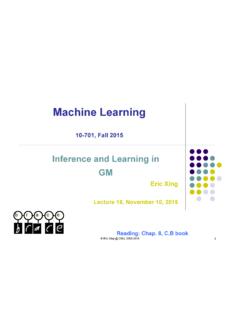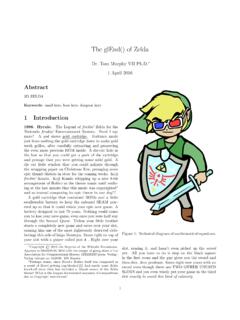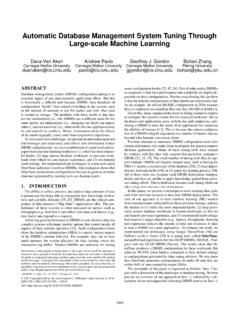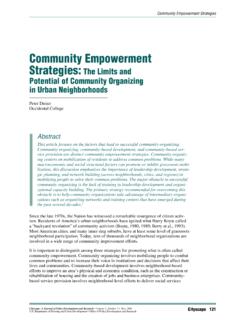Transcription of The Social and Psychological Impact of Online Gaming ...
1 The Social and Psychological Impact of Online Gaming Thesis Proposal Prepared by A. Fleming Seay November, 2004 1 Table of Contents The Domain - Massively Multiplayer Online Games ..3 Research Question One The Interplay of Addiction, Depression & self Regulation ..6 Addiction, Engagement, and Problematic 11 self -Regulation .. 13 A Susceptible 16 Research Question Two Player Motivation and 17 The Player 17 Research Question Three Displacement of Real Life Activities .. 20 Organizational 21 Discussion & Conclusion .. 22 Putting it all together .. 22 24 Acknowledgements .. 24 Appendix 30 Appendix 31 Appendix 33 Appendix 36 Appendix 37 Appendix 38 Appendix 39 Appendix 40 Appendix 42 Appendix 43 2 Introduction In 2003 it was estimated that 430 million people worldwide, or 7% of the world's population, played video games (Zona, 2004).
2 Over one quarter of these individuals did so Online and that number as a percentage of total video gamers continues to grow. In the United States, half of all Americans age six and older play video games (ESA, 2004). Having more than doubled since 1996, worldwide Gaming revenues, including hardware and software, were roughly $ billion in 2003, compared to $ billion in revenue for the film industry (Kagan, 2004; Zona, 2004). The Gaming demographic continues to expand alongside these impressive financials. The average age of the video game player in 2004 was 29, and 39% of gamers were female (ESA, 2004). As the demographics continue to diversify and revenue continues to mount, there is no sense in which Gaming can be defined as kid stuff . The average 13 - 24 year old in the United States watches hours of television per week compared to hours spent using the internet for activities other than email ( , 2003).
3 The average adult spends 4 hours per day (or 28 hours weekly) watching television ( Neilsen, 2001). Average weekly video game play is estimated in the 3-10 hour range. It is reported that people who play massively multiplayer Online games do so for an average of 15 hours per week; however, weekly usage of 30 hours or more is not uncommon (Seay, 2004; Yee, 2004). Given such a large industry with widening appeal and an expanding rate of use, questions arise about the Impact Gaming has on the Social life and Psychological wellbeing of the user. Despite a lack of hard data, reports in the popular media continue to suggest that the design and content of certain games are responsible for the detachment, depression, and even addiction that some players experience. It is commonly claimed that 10% of Online game players are addicted to the activity, an easy extrapolation from the equally questionable statistic that 10% of all users of the internet are addicted to it (Young, 1998; IGDA, 2003).
4 Vague and overly general lists of physical and Psychological symptoms from dry-eyes and carpal tunnel syndrome to problems with school or work are offered up as indicative of problem usage behavior (French, 2002; Orzack, 2004). Further, it is claimed that Online game players don t have normal Social relationships anymore and play Online games in order to cover feelings of anger, depression and low self - esteem (Scheeres, 2001; French, 2002; O' Dwyer, 2002). An article in the Shanghai Star claims that China houses over 40 million Online addicts, 80% of which are under 25 years of age (Boa, 2004). The alarmist media coverage of this burgeoning Social dilemma is not unlike that which meets many technological advancements or entertainment phenomena with deep penetration and wide appeal. The telegraph, nickelodeons, motion pictures, the phone, the television, video arcades, Dungeons & Dragons , the PC, the Internet; all of these have been at one time accused of being the harbinger of insurmountable Social ills.
5 It seems that it is Online Gaming s turn. One must be careful to not to be overly dismissive, however. Under increasing public and governmental scrutiny, a major Gaming industry group in Korea has laid out a multi-part initiative aimed at combating overuse of Online games through education, monitoring software and the establishment of treatment and rehabilitation centers. In a country like Korea where Online Gaming is so wildly popular and mainstream, even a small percentage 3of problem users could amount to a Social crisis. Anecdotal evidence also continues to mount. Support groups and Online communities with names like EverQuest Widows and Spouses Against EverQuest are available on the web full of stories about damaged and destroyed relationships. Communications of the ACM published an editorial on the deleterious Impact Online Gaming has on undergraduates, particularly Computer Science majors, in the United States (Messerly, 2004).
6 In addition, there do exist truly tragic stories, like that of the clinically depressed young man, described by many who knew him as addicted to EverQuest, who killed himself following an extended session of play (Miller, 2002). Using a longitudinal design, the proposed study will survey gamers in order to examine the Social Impact of Online Gaming in terms of commitment to the activity, interaction with real-life and Online -friends, and the more personal issues of problematic use and depression. This research places an emphasis on assessing the degree to which over-consumption of interactive entertainment is a causative factor of psychosocial difficulties or a symptom of self -regulatory deficits that are influenced by identifiable aspects of the user s personality and environment. Rather than presenting the monolithic view that Online games are bad or good, we predict that different motivations and styles of play are likely to yield different consequences for the user.
7 A model is proposed in which pre-existing player personality and concurrent Social factors such as self -regulatory deficits, loneliness, perceived Social support, and Social network size are more causative of overuse and depression than the "addictive gameplay" decried in the popular media. Here, problematic use of Online games is operationalized as consumption of an entertainment product in such amounts or at such times that it causes demonstrable problems in the user s real life. Most players, even those spending upwards of 40 hours a week Gaming , are simply adaptively engaged in an enjoyable activity that has little or no negative Impact on their well being. These players are able to manage their use of entertainment products, ensuring that Gaming remains a positive aspect of their lives.
8 Unfortunately, some players are not as successful at this self -regulation, and allow persistent involvement in Online games to interfere greatly with their everyday life. self -regulation is characterized by an individual s management of their own behavior through self -monitoring, evaluation against perceived standards, and self -administration of consequences for their own behavior. This research tests the hypothesis that deficits in self -regulation enable players to become overly engaged in Online play, and that these deficits are exacerbated by depression. Another hypothesis is that certain motivational and personality factors distinguish players who are more susceptible to use. Further, the proposed study will inform the design of software and behavioral strategies that will assist users in overcoming their self -regulatory deficits with respect to the consumption of interactive entertainment.
9 The Domain - Massively Multiplayer Online Games Though still the canonical picture of video game play, the solitary player sitting in front of a PC or television and interacting only with automatically generated visual and auditory stimuli is no longer the rule. Though the true beginning is a matter of considerable debate, text based Multi-User Dungeons (MUDs) began to captivate a niche of gamers with academic and commercial access to the internet throughout the 1980s by 4offering a collaborative Social experience in a persistent Online world. Due to their accessibility and penetration on college campuses with capable computer systems, MUDs became known pejoratively as Multiple Undergrad Destroyers. Phenomenal early Online communities like Lambda Moo, Habitat, and The Well grew and flourished around this collaborative communication technology in spite of its no-frills, command line appearance.
10 In the mid 1990s, even more players joined in as graphical, internet based multiplayer PC games like Meridian 59 and Ultima Online began to hint at the potential commercial and Social Impact of what would become the Massively Multiplayer (MMO) genre. With the widespread availability of broadband internet connectivity, and penetration of 3D acceleration hardware, graphically intensive multiplayer Online games are now a sizable part of the interactive entertainment industry. Today, comparatively few entertainment products for the PC ship without some form of networked multiplayer component, and the consoles, particularly Xbox, are following suit. Around the world, products like World of Warcraft and EverQuest II command audiences of 200,000 to million subscribers who purchase the client software for 30-60 USD and pay a monthly fee of around 15 USD to play (Woodcock, 2005).



















